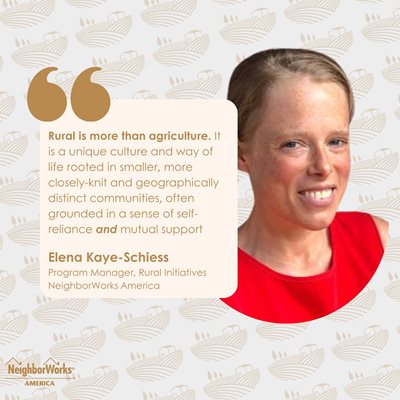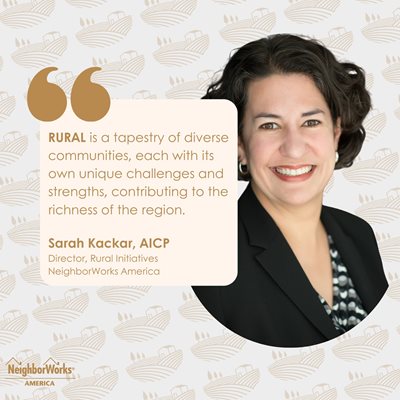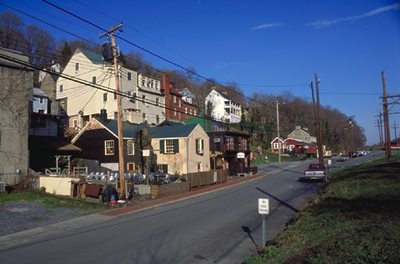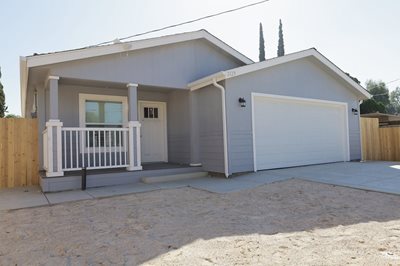What does it mean to be rural? And is it overdue a change in perspective?
"We want people to think of rural as an asset," says Elena Kaye-Schiess, program manager, Rural Initiatives. "A lot of rural communities have to be self-sufficient in many ways. As a result of that, there's an opportunity to breed innovation and solutions to challenges."
Rural communities are places of mutuality and reciprocity, she adds. "Neighbors know each other, so when something affects them, they think of new ways to work together and rely on each other to solve big challenges — economically, environmentally and more."
 This year, NeighborWorks America is celebrating its 45th anniversary. While anniversaries mark a good time to look back, Sarah Kackar, director of Rural Initiatives, is looking forward. She sees rural communities as becoming "increasingly diverse, connected and resilient." And her division is also looking forward.
This year, NeighborWorks America is celebrating its 45th anniversary. While anniversaries mark a good time to look back, Sarah Kackar, director of Rural Initiatives, is looking forward. She sees rural communities as becoming "increasingly diverse, connected and resilient." And her division is also looking forward.
Relying on each other
It was during the 1980s that NeighborWorks started what was then called "the rural experiment," developing rural network organizations using the Neighborhood Housing Services (NHS) model. The first of these programs was NHS of Southwest Wisconsin. As more rural organizations joined the network, says Kaye-Schiess, organizations relied on one another for support, especially when it came to leveraging each other's revolving loan funds.
The first project for NHS of Southwest Wisconsin (formerly NHS of Richland Center) was refurbishing the Park Hotel, built in 1873. "It was a stop on the stagecoach," says Cathy Lins, executive director of the organization. "At one point, it was the lobby for the greyhound bus station. It was a hotel. It was a flophouse."
By 1983, when the organization joined the NeighborWorks network, the building had fallen into major disrepair. Kids would throw rocks through the windows, already half empty of glass. "We needed housing for seniors, and we completely redid everything in the building," Lins says. The building opened in 1987 and included offices for the nonprofit.
Lins says her nonprofit has mirrored the work of NeighborWorks over the years. "Anytime NeighborWorks tried something new, NHS of Richland Center was going to do it, too. When NeighborWorks talked about a homeownership center, we said, ‘We'll do it.' New construction for single families? We'll do it."
As Rural Initiatives, as a team and a program, continues to grow, they've had more people to compare notes with. David Dangler, who first worked with NeighborWorks of Western Vermont, created an alliance of rural organizations, and went on to become the first leader of Rural Initiatives when the division officially formed in 2001.
alliance of rural organizations, and went on to become the first leader of Rural Initiatives when the division officially formed in 2001.
Since that time, the initiative has grown its membership from 37 organizations in 2007 to 115 members by 2017. Today, 121 members – nearly half of the NeighborWorks network – consider themselves majority rural-serving. NeighborWorks works to support these organizations through grants, trainings, peer collaboratives, outside resources and technical assistance that aides in capacity-building.
Lins says her organization has had access to national consultants and to other network organizations facing similar obstacles. "We can continually say, ‘here's what I'm looking at,' and get a response." In Wisconsin, they helped NeighborWorks Green Bay with their counseling load when the organization had an influx of clients during the pandemic. When Southwest Wisconsin was working on a HUD to new standards for their Homeownership Center, NeighborWorks Green Bay sent one they could examine. "We continue talking to each other; it's part of the process of what we do."
Some of the obstacles that NHS of Wisconsin and rural communities continue to face result from a shortage in housing stock. "When we looked at the research, we found that we have some of the oldest housing stock in the state," says Lins. Employers – including her own nonprofit – say it can be hard to hire people because there's no place for them to rent or buy. That's one area the organization is trying to address. During their 40 years, NHS of Southwest Wisconsin has built 53 new single-family homes. The current staff is working to get their capacity up so they can lead these kinds of efforts again.
In rural communities, people come together to tackle the obstacles, Lins says. "What I love about rural settings is most everybody wears multiple hats. You can talk to someone with fire department who is also working for the county and as a computer doctor as a side gig." In their own organization, a board member is also the high school football coach, a member of the fire department, and a branch manager of one of the local banks. And the community is at the center of everything.
"Over the years there has been a concerted effort to bring in rural-serving organizations," says Kaye-Schiess. The organizations have many of the same needs as urban organizations, but they have different needs, too. Eighty percent of the counties in the U.S. that face persistent poverty are rural counties, she adds.
Recent data from the Housing Assistance Council noted that rural poverty rates are higher for all races and ethnicities than for their counterparts in suburban or urban areas.
So as a national intermediary, how does NeighborWorks think about supporting those communities?
Supporting rural
The answer, for NeighborWorks Rural Initiatives, is any way they can. It's a bit of a buzz word, but one thing the division says will really help? Building capacity.
 In October, the Rural Initiatives team received a grant to build capacity in network organizations as part of the USDA's Rural Community Development Initiative grant program.(RCDI) program. NeighborWorks is using the opportunity to fund 85 hours of flexible, targed technical assistance for seven different network organizations. The organizations are seeking that assistance in a wide range of areas. At Arbor Housing in upstate New York, for instance, the nonprofit will work on establishing a Disaster Resilience Plan for its properties to address vulnerabilities due to climate stress. GROW South Dakota will receive assistance creating an individualized roadmap for federal funding resources, like the Greenhouse Gas Reduction Fund, to help offset high construction costs for workforce housing development.
In October, the Rural Initiatives team received a grant to build capacity in network organizations as part of the USDA's Rural Community Development Initiative grant program.(RCDI) program. NeighborWorks is using the opportunity to fund 85 hours of flexible, targed technical assistance for seven different network organizations. The organizations are seeking that assistance in a wide range of areas. At Arbor Housing in upstate New York, for instance, the nonprofit will work on establishing a Disaster Resilience Plan for its properties to address vulnerabilities due to climate stress. GROW South Dakota will receive assistance creating an individualized roadmap for federal funding resources, like the Greenhouse Gas Reduction Fund, to help offset high construction costs for workforce housing development.
"They're gaining a skill or knowledge their organization may not have had," Kackar says. "Then they can take the knowledge they've gained back to other parts of their service area and into community partnerships. The ideal outcome is that they'll be able to create something that's replicable. That's the core of capacity building."
Another focus is housing stock and exploring manufactured – or factory-built – housing. It isn't just for rural communities, Kackar says. But rural communities are one place where this type of housing is making a real difference.
For the past year, NeighborWorks has worked with Clayton Homes to support projects around factory-built housing as a means of increasing affordable housing. One of the benefits, Kackar says, is speed. The homes can be installed in weeks as opposed to six to 12 months for "stick-built" housing. There are mortgage options available, too. And many of the homes are built with climate resilience in mind, with thick walls and reinforced roofs.
The homes can be installed in weeks as opposed to six to 12 months for "stick-built" housing. There are mortgage options available, too. And many of the homes are built with climate resilience in mind, with thick walls and reinforced roofs.
NeighborWorks has offered a learning lab on manufactured housing for the past three years. This fall, Kackar hosted and coordinated site visits where groups – both urban and rural – could explore manufactured housing and ask questions directly to the largest manufacturer in this space. With recent support renewed for 2024, the Rural Initiatives team will coordinate two more site visits, each around different topic areas important to the network.
Meanwhile, Rural Initiatives is also collaborating with other national, rural intermediaries, Kackar says, as they work to see what they might be able to do as a combined force. "It's a new approach," she says. "We want to evaluate where we may find it difficult to move the needle alone, but together, may have greater impact when our goals and programs are aligned.
"This year is going to be exciting. There's going to be deeper collaboration at many different levels."
Connecting for the future
NeighborWorks' programs in rural communities have helped residents get greater access to quality affordable housing and essential community services. And communities "have access to tailored resources and expertise, sparking locally driven growth and development," adds Kackar. "Local community partnerships can flourish, leading to more cohesive resources in rural communities."
Sometimes, people think of rural communities as homogenous. Or they refer to rural communities as "getting back to the simple life." But to Kackar, there's more to rural communities, which encompass complex community networks and innovative practices. "They are a tapestry of diverse communities, each with its own unique challenges and strengths, contributing to the richness of the region."
01/31/2024

